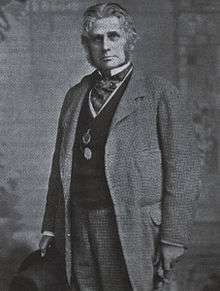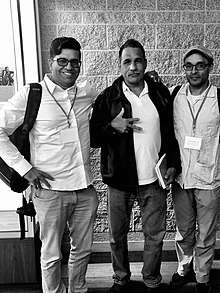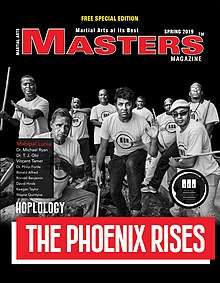Hoplology
Hoplology is a science that studies human combative behavior and performance.
| Hoplology | |
|---|---|
| Information | |
| Founder | Richard Francis Burton |
| Key people | Richard Francis Burton
A.H. Pitt Rivers Bronislaw Malinowski Donn Draeger Hunter Armstrong Michael J Ryan T.J. Obi Mahipal Lunia |
Etymology and history of the term
The word hoplology is derived from the Greek terms hoplos (a mythical plate-armored animal) and ὅπλον hóplon, a wooden shield carried by some warriors in ancient Greece. The word hoplite, derived from hoplon, is the term for the classical Greek warrior who carried such a shield. The field originates in the 19th century with Sir Richard Burton; although the origin of the word is often attributed to Burton, there are earlier references to it.[1] Despite the work of Burton and a few others, it was not until the 1960s that hoplology took shape as an academic field of study under the leadership of Donn F. Draeger.[1]
Hoplology was at some time defined as the science of "arms and weapons of offense and defence, human and bestial" (Burton, 1884),[2] and subsequently as "the study of the basis, patterns, relationships, and significances of combative behavior at all levels of social complexity" (Draeger, 1982).[3]
Sid Campbell, a black belt level, tenth dan-ranked in karate, defines hoplology as "the study of the evolution and development of human combative behaviour and performance ... the study of how people fight, why they fight, and how different cultures manifest those behaviours."[4]
More recently, hoplology is defined as the investigation and analysis of all forms of armed combat. It is most productively seen as an embodied event where the physiological and neurological structures of those individuals taking part in a combative encounter shape and, in turn, are shaped by cultural norms of what is right, effective, and efficient and so changes overtime and across space. As in all human encounters, every combat event is accompanied by a form of material technology and has been learned through a process of apprenticeship.
Warriors, Scholars, Explorers and their Hoplologies
1800s - The accidental Hoplologists': Burton & Pitt-Rivers

Several pioneering Anthropologists were also contributing to the field of Hoplology while Burton was active. A retired military officer who fought in the Crimean War, A.H.L. Pitt-Rivers developed a now outdated view of human evolution. Cultures, he concluded, evolved through time from technologically simpler societies to technologically complex societies. In other words, progress is an integral aspect of human history. Primitive Warfare 2. Oxford: The Journal of the Royal United Service Institution Vol. XII 1868 NO. LI. Working in the Trobriand Islands (just off Australia) around the time of WWI, the renowned Anthropologist Bronislaw Malinowski also delved into the field of Hoplology. "War and Weapons Among the Natives of the Trobriand Islands". Man. Vol. 20 pg.10-12 (1920).

Hoplology has always had a theoretical and practical orientation. Seeking to introduce more effective forms of close quarter combat to British soldiers Burton wrote two instructional manuals “ A Complete System of Bayonet Fighting.” London: William Clowes and Sons. 1853. And “A New System of Sword exercise for Infantry.” London: William Clowes and Sons.1876. while the memoir by the ex-Hussar F.J Norman’s “The Fighting Man of Japan: the training and exercise of the samurai.” London: Archibald Constable & CO.
1900s - The Surveyors': Malinowski, Banks, Draeger & Armstrong
During the post WWII era the International Hoplology Society ("IHS") was established by Major Donn F. Draeger (USMC Ret.) to study the evolution and development of human combative behavior. Draeger had prior research and personal experience of classical fighting systems. Draeger's student and colleague, Hunter B. Armstrong, went on to carry on Draeger's project as director of IHS. He continues closely with military and law enforcement, and has been central to the most recent recreation of the Marine Corps Martial Arts Program (MCMAP). Also, during this time working with Basil Richardson of the Victoria and Albert Museum, Roald Knutsen's wrote "Japanese Spear: Polearms and Their Use in Old Japan" (1963). Here he not only described the morphology of these weapons but explored how they were used by different schools or “ryu.”[5].

During the 1970's, The Republic of China began a number of academically based (and often government funded) investigations into several folk combat traditions. One drawback to many of these works is that they have yet to be translated in English, limiting the exposure of their findings. In other cases, they were inspired by ethno-nationalist or ideological considerations and no real effort has been made to engage with the growing international literature on Martial Arts Studies.
Major Expeditions
Malinowski, Bronislaw. 1914-1918: Trobriand Islands. An alien enemy on allied land Malinowski engaged in long- term research of Trobiand culture including warfare , raiding, inter - village conflict and war - magic.
Banks , E. 1930’s (est.). Sarawak Island , Indonesia. Research on weapons of the inhabitants of Sarawak.
Draeger, Donn. 1979. Sumatra, Draeger and his team visited the island of Sumatra. While visiting the Aceh tribe there, it appears that the entire group was somehow poisoned, perhaps deliberately.[6]
Overview of Draeger-IHS approach to Hoplology
Hoplology (as professed by Draeger-IHS) has three main research areas: technological, functional, and behavioral.
- Technological hoplology studies the development of weapons, armor, and other combative tools in relation to the contexts in which they are created.
- Functional hoplology delves into the structure, development, and organization of combative systems and their relationship to the application of fighting and weapons.
- Behavioral hoplology encompasses the psychological and physiological factors that affect human’s combative behavior and development of combative capabilities such as weapons or fighting systems. The broad subject range of behavioral hoplology means it also includes the effects that culture has had on man’s evolution as a group-social animal.
There are three IHS axioms in hoplological studies.[3]
- human combative behavior is rooted in man’s evolution.
- humans exhibit two types of aggression: affective aggression and predatory aggression. Both forms evolved from different survival needs as both a group-social animal and as a hunting animal.
- the evolution of human combative behavior is directly linked to the use of weapons. That is to say that the use of weapons is linked with and reflects combative performance and behavior.
A variation on the pragmatics of hoplological understanding is found in theatrical representations of combat.[7]
The Draeger-IHS hoplological view on violence: The entrenched nature of violence in human behavior is generally well understood. The skill and potential of deadly aggression is something within human genetics which predisposes humans to violent behavior. However, the genetics that predispose humans to violence is highly influenced by environmental factors. Humans will only tap into their violent potential once the need has arisen. Human genetics have developed an on-off switch in the brain. On the on side "…the fighting activity itself is stimulated by individual and communal thrill, enjoyment in the competitive exercise of spiritual and physical faculties, and even cruelty, blood lust, and killing ecstasy." (Gat 2006) On the off-side violence is deterred away by emotions through fear, revulsion at violence and bloodshed, physical fatigue, compassion, and spirituality. So if the environmental factors that cause a man to be violent are present, then he will be violent. If the environmental factors that cause a man to be violent are not present, he will abstain and deter violence.[8]
2000s - The Embodied Interdisciplinary Hoplologists: Lunia, Ryan, Obi, Tamer
More recently Anthropologists and other scholars have begun increasingly to examine how local people actually fight with weapons. Ethnographies such as Michael Ryan's Venezuelan Stick Fighting: The Civilizing Process in Martial Arts (2016). Philip Forde’s recently completed doctoral dissertation “Blocking both Hand and Foot: An Examination of Bajan Sticklicking” (2018) is another informative work. Avron Boretz’s Gods, Ghosts, and Gangsters: Ritual Violence, Martial Arts and Masculinity on the Margins of Chinese Society (2011) describes Kung Fu training with working-class men and petty criminals in rural Taiwan. Pentjak Silat on the island of Java was explored by Lee Wilson in Martial Arts and the Body Politic in Indonesia (2015).
In 2017 we saw an emergence of a New Hoplology, pioneered by The Immersion Projects. Immersion Projects continue to lead multiple expeditions, sponsor symposiums and launched a new journal[9] focused on the study of combat.
Major Expeditions
Armstrong, Hunter, July, 2003. Kerala, India. They interviewed over twenty teachers, took over a thousand photos, and about 50 video clips.[10]
Lunia Mahipal, Ryan Michael, Obi T.J. Nov 2018 Immersion Expedition: Barbados. Team of 9 members including 3 Phds lead the first expedition to study the arts of the African Diaspora in the Caribbean. The arts of Bajan Sticklicking, Trinidadian Gilpin, Kalinda and Indo-African Jab Jab were studied on an almost two week long expedition, with each workday being in excess of 16 hours. Everything was captured on two 4.6k BlackMagic cameras for posterity and over 2500 photographs. An entire special issue magazine was printed to commentrate the revival of expeditions.[11] An initial report of this historic expedition was published by Dr. Ryan, Dr. Forde and V. Tamer.[12] Dr. Ryan further published his experiences in another field report.[13]
Lunia, Mahipal, May 2019 Immersion Expedition: Portugal. The expedition studied the last 10 remaining schools of Jogo Do Pau. The team worked with the headmaster of the Fafe school, and his fighting methods in depth. All the 10 schools and their methods were captured on 4.6k cameras. the expedition concluded on a successful note with never shown before methods archived, multiple National TV coverages, a special meeting & facilitation with the Mayor of Fafe and coverage in major newspapers. Vincent Tamer successfully published a field report on this expedition.[14]
Current Trends - The New Hoplology

In 2018 a group of academics and veteran martial artists came together to explore the roots of bodily movements with weapons to uncover any underlying principles that shape all combat. Under the flag of a "New Hoplology" they conceptualized this study as an interdisciplinary project where in consideration of the diversity of its members, different research questions could be explored during the same project. One feeling shared among the group was to identify the most highly skilled exponents of combative systems. Those that were in the past and still today, first and foremost are seen and treated as combative arts that they have not evolved into modern recreations, sporting activities, folkloric representations of a past time. Next, they sought to conduct in-depth interviews and archive their system so s to provide a repository of data for future scholars and martial artists. Due to the nature of the project, these would be short term yet intensive research projects (typically ten 14-16 hour days of deep immersion in the cosmology, belief systems, history and combat methods). They are not meant to replace longer ethnographic research but to enhance and support other forms of research.
The Immersion Expeditions
The multidisciplinary team, under the flag of the New Hoplology has organized the following expeditions to date
- Bajan Sticklicking in the Caribbean[15]
- Trinidadian Kalinda and Toboggan Jab Jab in the Caribbean[16]
- Jogo De Pau expedition in Fafe, Portugal[17]
- Eskrima in Philippines
- Maori Wrestling arts of Rongomomau[18]

The first of these interdisciplinary expeditions was a roaring success in terms of collecting over 80 hours of film in a seldom seen art of Bajan Sticklicking. This was complemented by an equally in depth exploration of the arts of Trinidadian Kalinda and the seldom taught Afro-Indian whip art of Jab-Jab[19]. The entire expedition ended with a day of comparing & contrasting the arts of Bajan Sticklicking, Trinidadian Kalinda, Toboggan Jab-Jab, Venezuelan Garotte and Colombian grima. This was the first per all the keepers of these arts. The entire expedition was also covered in detail with a special free edition of the Masters Magazine aptly called "The Phoenix Rises.[20]"
The Immersion Symposiums
The following Global Symposiums have been organized by The Immersion team in California, USA. Each of the symposiums featured over 10 ambassadors/scholars/master practitioners of various arts, for a total of 30 hours over 3 days
- 2018 - The Legacy of the Blade[21] - was the successful beginning of studying blades of the world[22].
- 2019 - Stickmata[23] - Stick fighting: Man's oldest weapon received rave reviews[24] from participants and presenters alike.
- 2020 - Born of Blood[25] - The fierce fighting arts of the Pacific Rim. A historic gathering with very successful participant results[26] and academic reviews[27].
References
- Wiley, Mark V. "Hoplology and Combative Culture: Part 1". The International Hoplology Society. Retrieved 2009-03-07.
- Richard Francis Burton - The Book of the Sword: A History of Daggers, Sabers, and Scimitars from Ancient Times to the Modern Day - 7th page of Chapter 1 - Preamble: on the Origin of Weapons published by Skyhorse Publishing, Inc. 20 November 2013, 336 pages, ISBN 1628738472 [Retrieved 2015-07-27]
- International Hoplology Society - home-page published by the International Hoplology Society, Inc. 1998-2007
- Sid Campbell - Warrior Arts and Weapons of Ancient Hawai'i Blue Snake Books 2006, 266 pages, ISBN 1583941606 [Retrieved 2015-07-30]
- Masters Magazine Spring 2019 pg 35
- Nurse, Paul (May 2006). "Donn F. Draeger: The Life and times of an American Martial Arts Pioneer". Black Belt Magazine. Vol. 44 no. 5. Rainbow Publications, Inc. p. 122.
- Langsner, Meron (2006). "Chapter 10. Theatre Hoplology: simulations and representations of violence on the stage". In Constantinidi, Stratos E. (ed.). Text & Presentation. McFarland. p. 112. ISBN 0786455411.
- Gat, Azar. War in Human Civilization. New York: Oxford UP, USA, 2006. Print
- The Immersion Review, www.TheImmersionMedia.com/review
- India Trip Report by Hunter CS Armstrong, published on the now inactive IHS website.
- Masters, Martial Arts. "Hoplology: The Phoenix Rises".
- Ryan, Forde & Tamer. "SEARCHING FOR THE LAST OF THE STICK LICKERS: A Hoplological Expedition to Barbados". Academia.edu.
- "The New Hoplology: Stick, Machete and Whip Fighting in the Caribbean". Kung Fu Tea. 2019-03-15. Retrieved 2020-05-02.
- Tamer, Vincent. "Strife & Folklore: Discovering the rural fighting art of Jogo Do Pau". Academia.Edu.
- https://chinesemartialstudies.com/2019/03/14/the-new-hoplology-stick-machete-and-whip-fighting-in-the-caribbean/
- Ryan, Michael. "Stickman doh 'fraid no damom: Stick and machete fighting in the New world – Part 1".
- https://em3video.com/2020-spring-issue-masters-magazine-frames-video-free-download/
- https://chinesemartialstudies.com/2020/03/11/field-notes-sticks-blades-and-movement-along-the-pacific-rim/
- "Traditional Mas Characters - Devils and Jab Jab". www.ncctt.org. Retrieved 2020-04-07.
- "MASTERS Magazine SPECIAL EDITION (FREE) Spring 2019". EM3 Video - Masters Magazine. Retrieved 2020-04-07.
- Foundation, Immersion. "Legacy of the Blade". The Immersion Labs.
- Baier, Joshua. "The Priest, Prince, Peasant and Pirate". The Immersion Labs. Retrieved 2020-05-03.
- Foundation, Immersion. "Stickmata - Man's Oldest Weapon".
- Miksch, Dexter Immersion Lab #2 "Stickmata" Review, retrieved 2020-05-03
- Foundation, Immersion. "Born of Blood".
- Miksch, Dexter Immersion Labs: Lab #3 Born of Blood Review, retrieved 2020-05-03
- Ryan, Michael (2020-03-12). "Field Notes: Sticks, Blades and Movement Along the Pacific Rim". Kung Fu Tea. Retrieved 2020-05-03.
Further reading
- Amburger, Christopher, The secret history of the sword adventures in ancient Martial arts
- Carolyn Conley (1999) The agreeable recreation of fighting, Journal of social history
- Desch Obi, TJ (2008) Fighting for Honor: The History of African Martial Art in the Atlantic World (Carolina Lowcountry and the Atlantic World)
- Draeger, Donn F. (1979). An Introduction to Hoplology: Part I of II, Hoplos 1:1
- Draeger, Donn F. (1979). An Introduction to Hoplology: Part II of II, Hoplos 1:2
- Draeger, Donn F. (1982). The Hoplological Glossary, Hoplos 4:1
- Forde, Philip (2018) Blocking both Hand and Foot: An Examination of Bajan Sticklicking (Phd. Thesis)
- Lee, Wilson (2015) Martial Arts and Body Politic in Indonesia
- Ryan, Michael (2016) Venezuelan Stick Fighting: The Civilizing Process in Martial Arts